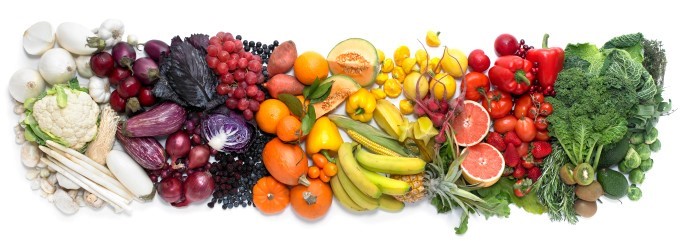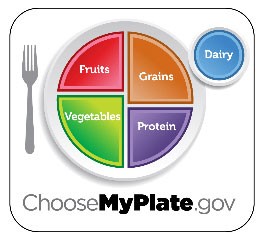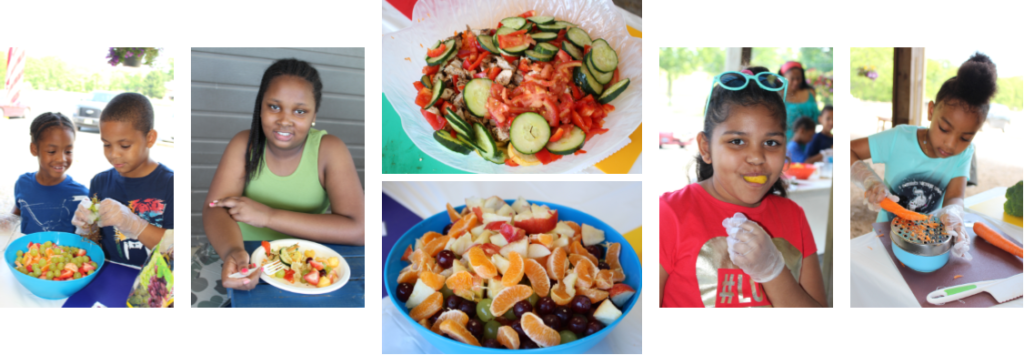Healthy Eating Tips
Four Simple Tips for Healthy Eating
The enthusiasm of New Year’s resolutions may be waning, but there is no need to give up on healthy eating goals! We will be running Healthy Eating Lessons through the beginning of the growing season, and we’re happy to let you in on some simple ways to keep the momentum going and stick to your goals. This year we’re adjusting our healthy eating program to make reaching goals more attainable for the youth we work with.
By using MyPlate as a reference, we’re structuring lessons around breakfast, lunch, and dinner and sometimes even adding in healthy snacks and desserts. Our team is working hard to ensure that the meals we create in the classroom are simple, tasty, and affordable. The biggest change to our program is that we are working hand in hand with the leaders at the organizations we partner with so that they can lead the lessons with more students using the supplies and produce that America’s Grow-a-Row provides.
Read on for a few tips to help you achieve healthy eating goals.

- Eat the rainbow
The colors of our food can tell us a lot about the nutritional value that we’re taking in. Being careful to ensure that you eat a variety of colors of fruits and vegetables is a simple way to fuel your body properly. Each color on your plate has multiple benefits to help your body function properly. You can find out more about phytonutrients found in plant foods on Fruits & Veggies More Matters as well as on Health Ambition.
For a simple way to eat your rainbow try having CORN at the end of the week – Clean Out Refrigerator Night! Make a stir fry with your leftover vegetables. It’s a great way to eat the rainbow and prevent food waste at the same time.

- Fill half your plate with fruits and veggies
MyPlate recommends filling half of your plate with fruits and vegetables at every meal. When we go to schools for our education sessions, the vast majority of youth we work with wildly underestimate the appropriate amount of servings of produce they should be consuming. The recommendation set by the USDA is 5-9 servings, and some health organizations even recommend more.
To encourage more produce consumption, try our lunch-themed Healthy Eating Lesson recipe. We created a sandwich filled with chicken salad using chicken, Greek yogurt, chopped celery, and grapes on whole wheat bread. For sides we added creatively cut cucumbers and carrots (this was a fun activity to practice knife skills too!) and skewers of apples and grapes that we deemed “fruit pops.” Feel free to switch it up with any fruits and vegetables you’d like!
*Image from Appetite for Health
- Watch out for added sugar
Added sugar can be lurking in more places than you might think. Even “healthy” options like granola, muffins, and bread often contain added sugar. Did you know that children should only have about 3 teaspoons of added sugar a day at most? During our breakfast-themed lesson, we explored how much sugar students might be consuming in a day and found most would be eating 15-20 teaspoons of sugar if they followed the sample meals we gave them to choose from. One student even charted 28 teaspoons of sugar in her hypothetical day of meals – that’s more than 9 days’ worth of sugar.
If you’re trying to be conscious of your sugar intake, reading labels is a great way to start. And try making more home-cooked meals. We created breakfast burritos with protein-packed eggs, spinach, and a whole grain tortilla to help children stay full and focused throughout the day without getting the jitters and negative health effects of too much sugar.

- Mix it up to try new things
Working on healthy eating goals often means trying new things. And let’s be honest, that can be daunting at any age! After years of running Healthy Eating Lessons, we’ve learned some ways of encouraging individuals of all ages to develop new tastes and turn what used to be a “yuck” into a “yum.” Here are a few tips:
- Use your senses and take it slow. Try smelling, feeling, and tasting the food. If you were hesitant to chomp down on something before but managed to place it on your tongue, it’s still a victory!
- Try it once, try it again. If you were willing to try a small bite of something once that’s fantastic. Didn’t like it? That’s okay. Don’t give up though. Try it again in a week, a month, or even longer. Studies show it takes multiple tries to develop a taste for something you didn’t like before. So keep trying!
- Try something you don’t like with a bite of something you do like. This is one of our favorite tricks. The next time you are trying something you don’t like, mix it up with other food on your plate. Not a fan of broccoli? Try tasting it with a piece of cheese. Brussels sprouts make you turn up your nose? Try it with a crunchy chopped walnut (or even bacon – we won’t tell!). While it’s important not to counteract the healthy produce by hiding it in unhealthy ingredients, it’s okay to use tasty bites to help encourage trying new things.
*Please note, America’s Grow-a-Row is not a medical organization. Consult your physician before making any dietary changes that may affect your health.








